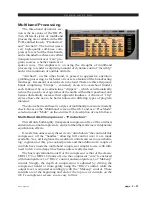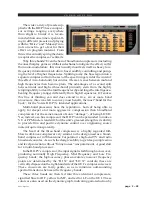
V O R S I S H D P 3 G U I
page 2 – 13
HD P3 / Aug 2006
Filter
High-pass, low-pass filters, and
notch.
High-Pass Filter
A fast rolloff-rate high-pass filter,
adjustable between 20Hz and 1kHz.
Notch
The notch is tunable over the en-
tire audio range of 20Hz – 20kHz.
Low-Pass Filter
A fast rolloff-rate low-pass filter,
adjustable between 20kHz and 1kHz.
Expander
An expander such as the one in
the HD P3 (often called a “down-
ward expander”) is a useful tool for
reducing unwanted background
noises. These could be variously
air-conditioning rumble or noise,
background conversation, phone-
line noises, recording hiss, etc. It is
also useful for reducing the inevi-
table general increase in back-
ground noise of some recorded
material when subject to heavy compression. A common usage in live
sound is to effectively turn a microphone off when not being talked/
sung into, so as to reduce corruption of a mix or reduce the chances of
feedback with an unwanted open microphone.
The expander is slightly counter-intuitive when first encountered,
in that unlike nearly any other processing element it is active - i.e.
working, attenuating away the input signal - when the input signal is at
its quietest, at or below the threshold. If the expander is on, there will
be gain reduction when no signal is present. The gain-reduction
reduces as the threshold is approached, and there is none above the
threshold.
The controls are:
THRESHOLD — Below which the automatic attenuation starts to
take effect.
RATIO — Being the proportion of how many dB the input signal
is attenuated for every dB it drops below the threshold. 1:3 indicates
18dB loss for 6dB drop in input signal level.
















































